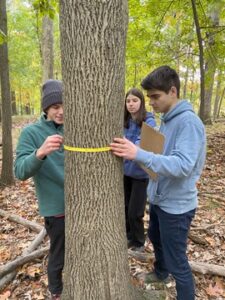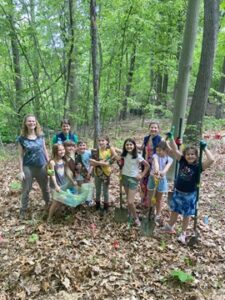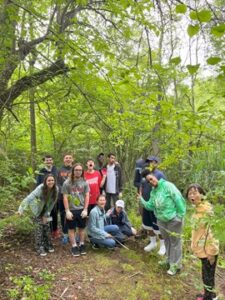
Irvington Woods Park is a special place. Beyond being the largest nature preserve south of I-287, it contains the most expansive wetlands in southern Westchester and is home to two giant rocks that seem to have been split in half with a cleaver.
Prominent residents include Revolutionary War General Philip Schuyler and Cyrus Field, who built the first telegraph line from the United States to Europe. Deep in the woods, the Hermit of Irvington’s grave is the only tombstone in the village.
But within this verdant spread, a silent killer looms. Beech leaf disease, discovered in northeastern Ohio in 2012, is harming the beech stands that constitute 17.5 percent of all the trees in Irvington Woods.
Last year, CJ Reilly, director of education and head of grounds and operations at O’Hara Nature Center and Irvington Woods, created a real-world suburban forestry lab staffed by 32 afterschool volunteers from grades K to 12 that linked up with the Long-Term Ecological Research Project at Harvard Forest.
Irvington’s scientists helped establish a sophisticated benchmark to underscore future research projects by tapping the talents of diverse learners from different grades, said Katharine Hinkle, schoolyard ecology program coordinator at Harvard Forest, a 4,000-acre lab and classroom affiliated with the university and located in central Massachusetts.
“The Irvington project surpassed our expectations in the breadth of data and the huge range of students that they are reaching,” she said. “[Reilly] brings a lot of rigor to the program and the kids are engaged and invested.”

Most of the 200 or so localized Harvard Forest research projects set up one or two research sites in the wild, said Hinkle. There are now ten, 10-by-10-meter sites in Irvington Woods.
“These long-term research plots will last as long as no one takes the tags or removes the PVC pipes,” said Reilly. “We’ve defined some quadrants and folks from Cornell and Harvard – along with the public – can access this data, come to the woods and take measurements.”
Building on an arborist’s report prepared for the village many years ago, the research team analyzed soil samples, mapped invasive species and, in addition to setting up the randomized research sites, took core samples from several trees.
Reilly contends that Irvington Woods is potentially as old, or older, than the New York Botanical Garden in the Bronx. Few old-growth trees survive in the region because they stood in the way of farming from the 1600s to the 1800s and housing in the 1900s and 2000s.
Last month, Reilly’s eyeball review of a core sample revealed that one of the oldest white oak trees in the forest dates to around 1705. The exact date will be determined with a scanner and a microscope.
The good news is that it’s in “super healthy condition,” he said. “This and many others are witness trees to the Revolutionary War and Washington Irving [the village’s namesake].”
Beyond tracking history, the core samples also reveal the effects of drought and other trauma, including beech leaf disease, first identified by Westchester authorities in 2018, said Reilly.

Research on the scourge is so scarce that the Irvington foresters are in the forefront of discovering when the disease arrived, figuring out how long the trees will live and determining whether or not they will perish at the same time, said Reilly.
“We don’t always get answers when we conduct research, but it can lead to helping the students investigate deeper and ask better questions,” he said.
“This disease is spreading fast in the Northeast and there are few research forests documenting the frontline of its migration,” said Hinkle at Harvard. “What they’re doing in Irvington is very interesting and very helpful.”







Hi Jean. Yes, you can reprint the article. Please send me a link (publisher@rivertownsmedia.com) when it is live and we will share it with Marc. Thanks. Alain
Hi Marc,
Good article. I am the editor of the New York State Urban Forestry Council’s weekly blog/newsletter, Taking Root. I’d like to reprint the article in TR, with your byline as a Contributing Writer. Would that be possible? You can write me at editor@nysufc. org, and see our blog with other posts at nysufc.org. Let me know please!
Jean Zimmerman